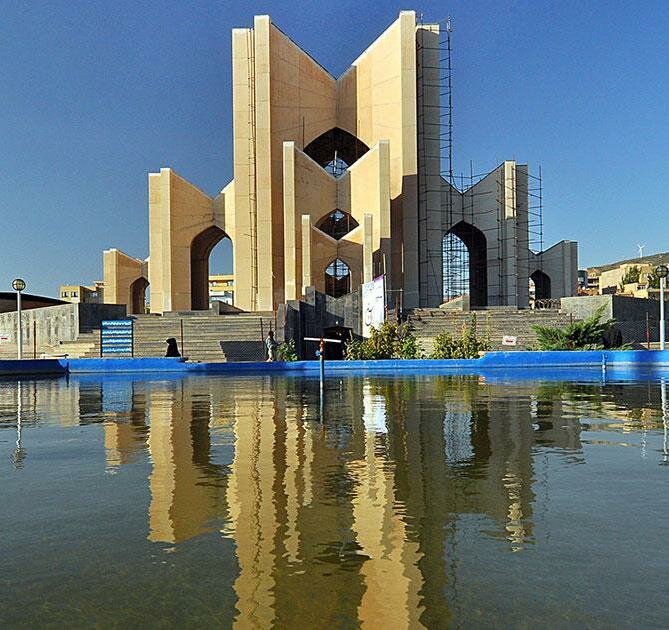TEHRAN – Poets’ Mausoleum or Maqbaratoshoara is a prime cultural destination for travelers to Tabriz. It attracts a great number of Iranian and foreign visitors interested in literature and art.
Some visitors say the site is photography heaven. Scenic, angular and interlocking concrete arches of the mausoleum maybe best viewed through a reflecting pool from the south.
Located in Sorkhab district, Maqbaratoshoara is where over 400 writers, poets, mystics and linguists are buried from the 11th century onwards. It is a testimony to the glorious cultural scene of the northwestern Iranian city.
Formerly known as Sorkhab cemetery, its original texture was hurt by earthquakes and floods over the course of time until it was renovated and adorned with a memorial monument in the 1970s. The precise date of its establishment is not known.
Its modern design was developed by Iranian architect Gholamreza Farzanmehr who made an amalgam of modern and traditional elements of Persian architecture. Construction operation started in 1972 and was completed in 1982.
Iranian poet, linguists, and author Abu Mansur Ali ibn Ahmad Asadi Tusi is believed to be the first literary figure buried at the mausoleum. Narratives say that a tradition was established by entombing other prominent classical poets such as Khaqani, Anvari Abivardi, and Qatran Tabrizi.
Poets Shamseddin Sojasi, Shapur Nishapuri, and Homam Tabrizi are other examples of literary and cultural figures buried there.
Mohammad-Hossein Shahriar (1906 – September 18, 1988) is probably the most renowned contemporary Iranian poet being laid to rest at the site. His mausoleum is situated in the middle of the complex with almost 30 meters in height.
Soaked in history and dotted with splendid vibrant historical sites, Tabriz has much to offer its visitors such as Azarbaijan Museum, Arg-e Tabriz, Elgoli Park, Shahriyar House Museum, Municipal Hall, St Mary’s Church, Qajar Museum, Constitution House, Khaqani Park, and Sarkis Church just to name a few.
Tabriz has long been a place of cultural exchange since antiquity. Its UNESCO-registered bazaar complex gives reference to the city’s glorious past when it was a peak commercial center on the Silk Road.
It is also famous for having hospitable people, ubiquitous carpet shops, abundant public places and efficient transport system.
Under travelers’ eyes
Here is a select of comments that visitors to the Poet’s Mausoleum have posted to TripAdvisor, one of the most popular travel websites in the world:
“Tombs of poets”
The structure of the monument catches your eye from a far and you wouldn't know at once that you are entering a sepulcher. The places is the resting place for a large number of Tabrizi poets, the most famous of whom is Shahriar. Now, due to renovation process, one may not be able to get the photos he wishes to outside of the building. (Reza Sattarzadeh from Muscat, Oman; Reviewed September 2018)
“Visit the tombs”
After my visit I would say the outside of the building was more impressive then the inside. There are only a few tombs inside. (Leovanstraten2015 from Leeuwarden, the Netherlands; Reviewed April 2018)
“Not interesting”
The monument itself is not worth visiting, but the climb uphill and the view over Tabriz and its surrounding areas is splendid. If you decide to climb uphill together with a lot of locals you should do it in the early morning before it becomes too hot. (Rsmidt1959 from Amsterdam, the Netherlands; Reviewed December 2017)
“Very interesting”
Not somewhere we would normally visit but we did to try and better understand the Iran people, we are glad we went. Unfortunately work is being done outside which restricts the views but inside was very interesting. (Youngone51 from New Plymouth, New Zealand; Reviewed October 2017)


No comments:
Post a Comment